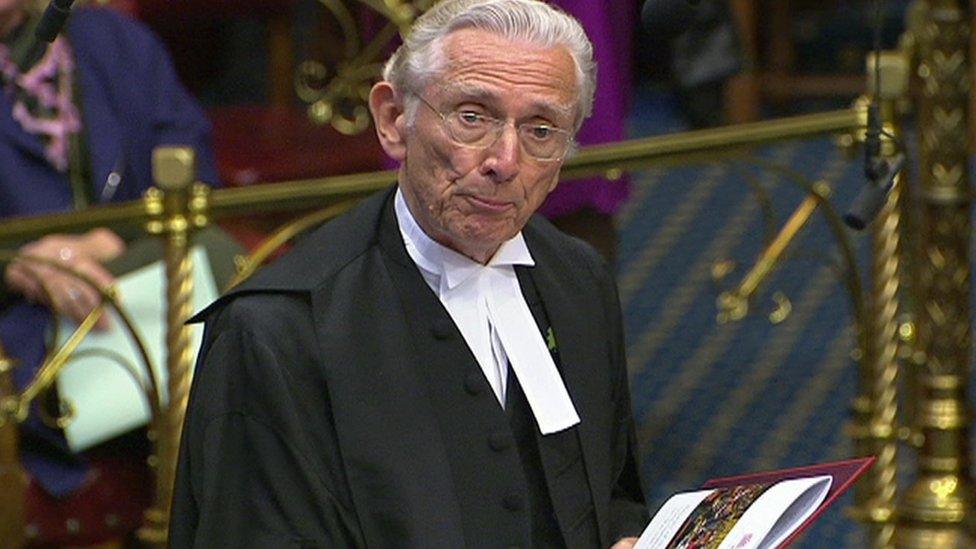House of Lords 'should cut number of peers to 600'
- Published
- comments

The Lords Speaker said cross-party agreement was vital to see the changes through
Peers would be limited to 15 years in the House of Lords as part of plans to cut membership by a quarter from the current 800 over the next decade.
With 799 eligible members, the Lords is the world's second largest legislative body after China's People's Congress.
Ex-civil servant and cross-bench peer Lord Burns was commissioned by Lords Speaker Lord Fowler to look at ways to slim down the size of the Lords.
His report proposes, external capping the size of the House of Lords to 600 members.
The House of Lords, most of whose members are appointed, plays an important role in scrutinising and revising government legislation but its critics say it has become bloated.
The Burns report recommends a "two-out, one-in" system for reducing the size of the chamber, with only half of those peers relinquishing their seats over the next decade or so being replaced.
It envisages 150 peers departing between 2017 and 2022, taking into account deaths and voluntary retirements, with this number increasing to 250 between 2022 and 2027.
During that period, only 200 new peerages would be approved, reducing the total size of the House to 600.

Who sits in the Lords?

The House of Lords plays an important role in scrutinising and revising government legislation
The Conservatives have the largest number of peers - with 252 members - but they do not have a majority as they are heavily outnumbered by other groups.
Labour has 191 peers while the Lib Dems have 100. There are 181 crossbenchers who are nominally independent and do not take the whip of any of the main parties.
There are 29 non-affiliated peers - individuals who once belonged to a party but have since left - and 14 peers who represent other parties such as UKIP, the Green Party and the Democratic Unionists.
There are 26 spots set aside for Anglican bishops although only 24 of these are currently filled.
There are 91 hereditary peers who remain following the expulsion of their remaining number in 1999. Each time one of their number dies, they are replaced by a hereditary peer of the same political persuasion in a by-election.
There are a handful of peers who are currently ineligible because they are on leave of absence or are disqualified because there are members of the Supreme Court or European Parliament.

The report suggests political parties would be expected to "contribute the same proportion" of their current membership each year towards meeting its target and if necessary "persuade" individuals to stand down.
Under its formula, 129 Conservative peers would be expected to depart by 2027 while Labour and the Lib Dems would see 102 and 50 departures respectively and 93 crossbenchers would also leave.
At the moment, peers can serve for life once appointed, although rules brought introduced in 2014 making it easier for them to retire has increased the turnover in the House.
In the past five years, 125 peers have either retired or died.
'Radical'
Lord Fowler said none of the proposed changes required legislation and could be achieved within a decade with the support of the parties and the government.
The report envisages the 91 existing hereditary peers and 26 bishops remaining in place but it notes that ministers would have to decide whether it was "sustainable" for hereditaries to make up a larger proportion of the total number than they do now.
The key recommendations include:
All new peers would be expected to give an undertaking to stand down after 15 years or breach the code of conduct.
No party would be allowed an absolute political majority
A minimum of 20% of seats would be reserved for independent crossbenchers, members largely appointed by the House of Lords Appointment Commission
Political appointments would be shared between the parties in line with the result of the previous general election
This would be defined as an average of the parties' share of the national vote and of the seats won in the House of Commons
A new category of life peerage could potentially be created which does not grant membership of the Lords
The changes are designed to ensure the future make-up of the House of Lords reflects "the political views of the country over the medium term".
Alternative options rejected by the committee include setting a mandatory retirement age and removing members with the lowest attendance and participation rates.
Lord Fowler said the Lords played a vital role in holding the government to account.

The UK's most senior Anglican clergy will continue to sit in the Lords
But he added: "However with over 800 members - about 150 more than the Commons - we are too large. The time has now come to take action to correct this and put a cap on numbers for the future.
"A smaller, more effective house will be able to build public confidence and support for its crucial constitutional role in checking bills before they become law."
Lord Burns said his proposals were a "radical but achievable" answer to an issue that had "defied resolution for so long".
"Our proposals would see the numbers come down to 600 and stay there, while also allowing the membership to be refreshed and to reflect changing public opinion over time," he said.
Downing Street said it would study the report carefully but "comprehensive" reforms were not a priority.
- Published14 September 2017

- Published20 December 2016
